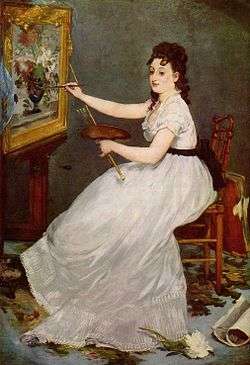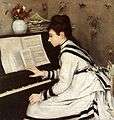Eva Gonzalès
| Eva Gonzalès | |
|---|---|
.jpg) Eva Gonzalès (1849-1883) | |
| Born |
April 19, 1849 Paris, France |
| Died |
May 6, 1883 (aged 34) Paris, France |
| Nationality | French |
| Known for | Painting |
| Notable work | Une loge aux Théâtre des Italiens (1874) |
| Movement | Impressionism |
| Spouse(s) |
Henri Guérard (m. 1879) |

| Wikimedia Commons has media related to Eva Gonzalès. |
Eva Gonzalès (April 19, 1849—May 6, 1883) was a French Impressionist painter.
Early life
Eva Gonzalès was born in Paris into the family of the writer Emmanuel Gonzalès.[1][2] In 1865, she began her professional training and took lessons in drawing from the society portraitist Charles Chaplin.[3] Through her father’s connections as a founding president of the Société des gens de lettres, she met a variety of members of the Parisian cultural elite, and from a young age was exposed to the new ideas surrounding art and literature at the time.[4]
Student of Edouard Manet
Gonzalès became a pupil of the artist Édouard Manet in February 1869.[5] Manet is said to have begun a portrait of her at once, which was completed in March 1870 and exhibited as Mlle E.G. at the Salon in that year. Unfortunately her debut submissions to the Salon, also in 1870, were overshadowed by the presence of Manet's portrait. His painting depicts her working at an easel, yet her stiff posture and expensive dress are clearly unfit for creating artwork.[6] This depiction of her likely caused some critics to perceive her simply as a young, beautiful, decorative model who was working with an older established male painter. Gonzalès was Manet's only formal student and also modeled for several members of the Impressionist school.[2] Manet's Mlle E.G. was discussed more than Gonzalès' oeuvre at her own 1885 retrospective and at the Galerie Daber's exhibition for her work in 1950.[7]
Work, exhibitions, and critical reception
Gonzalès' work was celebrated by Salon reviewers for the inherent intuition with which she approached art, as well as her intrinsic technical skill.[4] At one point she listed herself as a student of Charles Chaplin with her submissions to the Salon, perhaps as a method to be taken more seriously. Much of her work became characterized through Salon reviews with discussion of her "feminine technique" and her "seductive harmony." However, her large-scale painting, Box at the Théâtre des Italiens (1874), was characterized by the Salon jury as having "masculine vigour," which led them to reject it with questions as to her painting's authenticity.[3] Nevertheless, her work was reviewed positively by a variety of critics. Louis Leroy, Jules Castagnary, and Émile Zola praised the work she successfully showed at the Salons.[4] Furthermore, the art critic Maria Deraismes championed Gonzalés for producing paintings which challenged the way female painters were viewed and separated from the art scene in Paris.[8]
Like Édouard Manet, Gonzalès never exhibited in the Impressionist exhibitions in Paris, but she is considered part of the group because of her painting style. While studying under Manet, Gonzalès' self-portraits suggest that she was exploring her individuality and identity as an artist by presenting subtle correctives to Manet's version of her. Until 1872, she was strongly influenced by Manet but later developed her own, more personal style. This can be seen in works such as Enfant de Troupe (1870), which is a nod to Manet's Le Fifre (1866), while many of her later paintings involved portraits of her sister, Jeanne.[9]
In 1879, she married Henri Guérard, a graphic artist and Manet's engraver.[2] She used her husband and her sister, Jeanne Gonzalès, as models.[9] During the Franco-Prussian War she sought refuge in Dieppe.[3]
Her work was exhibited at the offices of the art review L'Art in 1882[2] and at the Galerie Georges Petit in 1883.
Death
In 1883, Gonzelès died in childbirth at the age of thirty-four,[1] five days after the death of her teacher, Edouard Manet.[10] In 1885, a retrospective of 88 works was held at the Salons de La Vie Moderne in Paris.[2]
Gallery
 Lady with a Fan, 1869–70
Lady with a Fan, 1869–70- Enfant de troupe, 1870
 L'Indolence, 1871–72
L'Indolence, 1871–72 La jeune élève (Portrait of Sister as Artist) 1871-72
La jeune élève (Portrait of Sister as Artist) 1871-72 Plage de Dieppe, vue depuis la falaise Ouest, 1871
Plage de Dieppe, vue depuis la falaise Ouest, 1871.jpg) L'Avant Port (Dieppe), c. 1871
L'Avant Port (Dieppe), c. 1871 Une loge aux Théâtre Italiens, 1874
Une loge aux Théâtre Italiens, 1874 Le petit lever, 1875
Le petit lever, 1875 Morning Awakening, 1876
Morning Awakening, 1876 Nounou avec enfant, 1877–78
Nounou avec enfant, 1877–78 Secretly, 1877–78
Secretly, 1877–78 The Milliner, c. 1877
The Milliner, c. 1877 La Toilette, 1879
La Toilette, 1879 Portrait of a Woman in White, 1879
Portrait of a Woman in White, 1879 Woman in White, 1879
Woman in White, 1879 White Shoes, 1879–80
White Shoes, 1879–80 Reading in the Forest, 1880
Reading in the Forest, 1880 Afternoon Tea, or On the Terrace, 1875
Afternoon Tea, or On the Terrace, 1875 The Donkey Ride, 1880
The Donkey Ride, 1880 Roses dans un verre 1880-82
Roses dans un verre 1880-82 Portrait of Jeanne Gonzalès in Profile
Portrait of Jeanne Gonzalès in Profile
References
- 1 2 Heller, Nancy G. (1987). Women Artists. New York: Abbeville Press. p. 94.
- 1 2 3 4 5 Clement, Russell T.; Houze, Annick; Erbolato-Ramsey, Christiane (2000). The Women Impressionists: A Sourcebook. Westport, CT: Greenwood Press. p. 165.
- 1 2 3 Gaze, Delia, ed. (1997). Dictionary of Women Artists. Chicago: Fitzroy Dearborn Publishers. pp. 596–599.
- 1 2 3 Fine, Elsa Honig (1978). Women & Art: A History of Women Painters and Sculptors from the Renaissance to the 20th Century. Montclair, NJ: Allanheld & Schram. OCLC 3415319.
- ↑ "Edouard Manet, Eva Gonzalès". National Gallery, London. Retrieved 10 October 2016.
- ↑ Garb, Tamar (1986). Women Impressionists. New York: Rizzoli. OCLC 14368525.
- ↑ Emmer, Janalee. "Rethinking Self: Eva Gonzalès (1849-1883) On Her Own" (PDF). Ohio Wesleyan University. Retrieved 7 March 2015.
- ↑ Boime, Albert (1994). "Maria Deraismes and Eva Gonzalès: A Feminist Critique of 'Une Loge aux Théâtre des Italiens'". Woman's Art Journal. 15 (2): 31–37. JSTOR 1358602.
- 1 2 Riding, Alan (28 October 1993). "3 Artists Who Left A Fainter Impression". The New York Times. Retrieved 8 March 2017.
- ↑ Weidemann, Christiane; Larass, Petra; Klier, Melanie, eds. (2008). 50 Women Artists You Should Know. Munich: Prestel. OCLC 195744889.
Further reading
- Marie-Caroline Sainsaulieu and Jacques de Mons. Eva Gonzalès: 1849-1883: Étude critique et catalogue raisonné. Paris, 1990.
- Marianne Delafond. Les femmes impressionnistes: Mary Cassatt, Eva Gonzalès, Berthe Morisot. Paris. 1993. ISBN 2-85047-227-1.